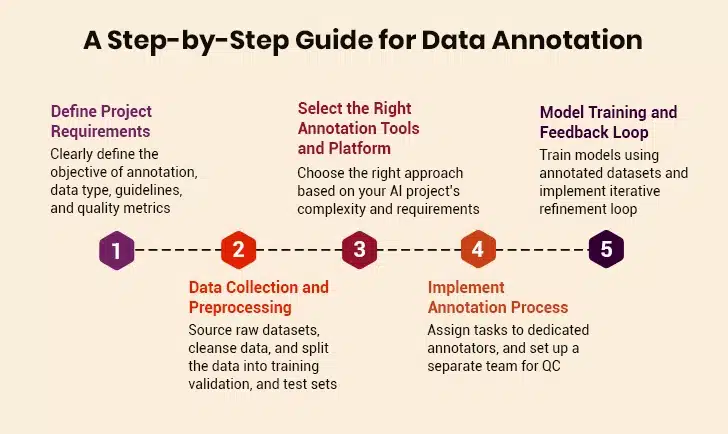Businesses across different industries and verticals stand at crossroads. Just when leaders made way for AI and ML in their workflows and business models, AGI stole the spotlight. AGI stands for Artificial General Intelligence, which is a hypothetical type of AI with the ability to think and work like humans. The irony is, no matter the level of advancements, what lies at the core of both these is the need for human expertise and insights.
Or, let’s put it this way, AI and ML models used across businesses, processes, and industries are taught to make accurate predictions and recognize patterns. It is through the data annotation process that machines learn to perform the desired actions.
Table of Contents
What Is Data Annotation in Machine Learning?
What Is the Current State of Data Annotation?
What Are the Key Challenges in Data Annotation and How to Resolve Them?
What Are the Trends Reshaping Data Annotation Industry?
- Growing Demand for Industry-Specific Annotation Solutions
- Real-Time Annotation Capabilities
- Collaborative Annotation Platforms
- Ethical Considerations and Bias Mitigation
- Augmented Reality (AR) and Virtual Reality (VR) Annotation
- Multi-Modal Annotation on the Upswing
- Enhanced Data Security and Privacy Measures
The Human Element in Data Annotation Services for Machine Learning
What Is Data Annotation in Machine Learning?
Data annotation is the process of labeling or tagging data to make it understandable for machine learning models. Human-in-the-loop approach and automated tools or a combination of both are used to add meaningful labels to raw data, whether it’s text, images, audio, or video. How well the AI model performs directly depends on the quality of training datasets. Thus, it is right to say that data annotation plays a key role in driving the accuracy of AI and ML models.
Further, data annotation varies, depending on the type of data. For instance, image annotation involves drawing bounding boxes around objects. On the other hand, text annotation includes sentiment analysis and entity recognition. This diversity in annotation types reflects the complexity and sophistication required in modern AI applications.
What Is the Current State of Data Annotation?
It’s no secret that data annotation is critical for training AI and ML models. And, as more businesses use these algorithms in their workflows, the demand for data annotation increases. The latest reports state that the global data annotation tool market size is projected to reach USD 5,331.0 million by 2030, growing at a CAGR of 26.5%.
Such an upsurge in the data annotation market is due to the fact that AI and ML solutions are making processes more efficient across industries. Given this boom, the data annotation market is growing, as the process lays the foundation for reliable machine learning models. At the same time, the rapid growth of data, both in volume and variety necessitates businesses to learn how to deal with huge volumes of training datasets.
Big data, which is one of the most influential trends, has emerged consequently. This big data, along with the ongoing advances in AI, ML, and other solutions created to handle humongous volumes of data, directly impacts the development of the data annotation industry. Nonetheless, this process is not without its challenges. And the good news is that all of these issues can be addressed. Thus, businesses can easily train and use their AI and ML models.
What Are the Key Challenges in Data Annotation and How to Resolve Them?
Despite its importance, data annotation has several challenges that companies must resolve carefully. Understanding them is essential for developing effective annotation strategies. So, let’s explore them in detail:
1. Quality Control and Consistency
Maintaining labeling consistency across large datasets is difficult. Even though human annotators are experts, they can introduce variations because of different interpretations. This inconsistency often creates performance issues, leading to unreliable outcomes. To avoid this, companies should set up quality assurance processes, such as multiple reviewer systems and calibration sessions.
2. Scalability and Resource Constraints
The vast ocean of data to be annotated is often overwhelming. What’s even tough is labeling this data manually. It is like racing against time where many businesses often end up trading off quality during data annotation. Instead, the smarter way is to explore new solutions, such as crowd-sourcing platforms and hybrid annotation approaches.
3. Domain Expertise Requirements
Specialized fields such as medical imaging, financial document analysis, and scientific research require annotators who have proper domain knowledge. Finding such qualified experts is an uphill task, especially when there’s resource scarcity. Another persistent challenge is to maintain cost effectiveness. The ideal solution is to partner with a data annotation company that has the required potential to meet the requirements specific to your business.
These are some of the challenges and considerations that leaders must take care of when considering AI and ML development and training. Moving on to the next, let’s explore the trends in data annotation for machine learning.
What Are the Trends Reshaping Data Annotation Industry?
The increasing demand for data annotation is primarily due to the growing use of machine learning models in research and other commercial applications across a range of segments. This includes healthcare, manufacturing, security, and surveillance, among others.
Once a narrow niche, data annotation boomed into a giant industry. There are numerous fascinating things in data annotation to look forward to in 2025 and beyond:
I. Growing Demand for Industry-Specific Annotation Solutions
Every industry has unique requirements. What works well for insurance might not be sufficient for logistics. As AI and ML applications become more specialized across various sectors, such as healthcare, finance, agriculture, etc., there’s a need for data annotation services tailored to the unique needs of each domain.
For example, in medical image annotation, accurate labeling of MRIs, X-rays, and CT scans is important for AI-powered diagnosis. Any incorrect label can be dangerous, especially in cases where an individual’s life is at stake. Thus, businesses are looking for annotation providers with expertise in their specific industry to get quality and accurately labeled data for their AI projects.
II. Real-Time Annotation Capabilities
The demand for real-time data processing and immediate insights is driving the development of real-time annotation capabilities. Industries such as autonomous vehicles, financial trading, and emergency response systems require instantaneous data annotation to make split-second decisions. This trend is pushing annotation providers to develop low-latency solutions that can process and label data streams in real-time without compromising accuracy.
III. Collaborative Annotation Platforms
The rise of collaborative annotation platforms is changing how companies approach data labeling projects. These platforms enable distributed teams of annotators to work simultaneously on large datasets. This approach allows for real-time collaboration, version control, and automated conflict resolution. This, consequently, speeds up the annotation process and improves overall quality through peer review mechanisms.
IV. Ethical Considerations and Bias Mitigation
Ethical AI and bias mitigation are of immense importance. Thus, there’s an increasing emphasis on ethical data annotation practices, which means that there’s fairness, transparency, and impartiality in the procedure. Potential biases introduced via manual labeling, as every human annotator has different views, values, and opinions, can exacerbate existing social inequalities by resulting in discriminatory outcomes.
Data annotation companies are adopting guidelines and putting in place the best practices to ensure transparency, fairness, and inclusivity in AI systems. They are also investing in AI data annotation solutions that help identify and mitigate biases in annotated datasets, contributing to the development of responsible AI.
Perform the ROI Analysis of Data Annotation for AI Models
V. Augmented Reality (AR) and Virtual Reality (VR) Annotation
The growth of AR and VR technologies has opened doors for data annotation that leads to the spatial computing domain. In AR and VR annotation, objects and scenes in immersive environments are labeled. This is central for applications such as augmented reality glasses, autonomous vehicles, and virtual training simulations.
VI. Multi-Modal Annotation on the Upswing
Multi-modal AI is reshaping the data annotation landscape. It combines different data types like image, audio, video, and text. Businesses are looking for a reliable data annotation company capable of labeling data across various modalities. Thus, they can build advanced models that understand and process data from multiple sources.
VII. Enhanced Data Security and Privacy Measures
The importance of data security and privacy cannot be overstated, especially in light of increasing data breaches and regulatory scrutiny. Thus, there’s a dire need to strengthen data security and privacy measures for data annotation. As a safety measure, annotation providers are using encryption protocols and access controls and adhering to data protection regulations such as GDPR and CCPA.
These are some of the trends that are face lifting the data annotation landscape. However, no matter how many automated tools and services emerge, human elements will always remain an inevitable part of data annotation. This human element is better known as the human-in-the-loop approach, which is necessary to keep a check on how the machines perform.
The Human Element in Data Annotation Services for Machine Learning
No matter how advanced data annotation is, the human element remains irreplaceable. That’s because humans understand the context very well and have cultural sensitivity. Annotators are given thorough training to understand project requirements, maintain consistency, and handle edge cases that automated systems might miss.
They can make nuanced judgments, which automated systems do not have and fail to replicate. Their ability to adapt to new scenarios and provide feedback on annotation guidelines contributes to the continuous improvement of annotation processes. So, the most successful projects combine human expertise with technological efficiency. This way, they can benefit from the strengths of both worlds.
Closing Thoughts
Although the process is laced with challenges, data annotation in machine learning has a promising future. What’s the best part is that this market is poised for significant growth. Industry-specific data annotation services, AR and VR annotation, multi-modal annotation, ethical considerations, and data security are the top trends influencing this industry. These trends highlight the role of data annotation in training and deploying responsible AI and ML applications across industries.
And as businesses continue to use AI in their processes, staying updated with these trends is important. What sets you apart from your peers is the ability to adapt to these trends and pull them to your advantage. This not only improves the quality of your AI models but also positions your business as a leader in the industry.







